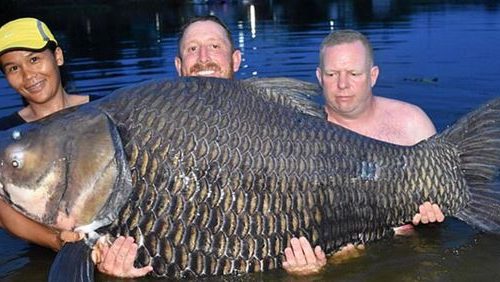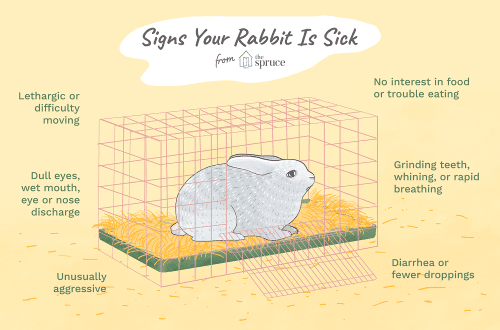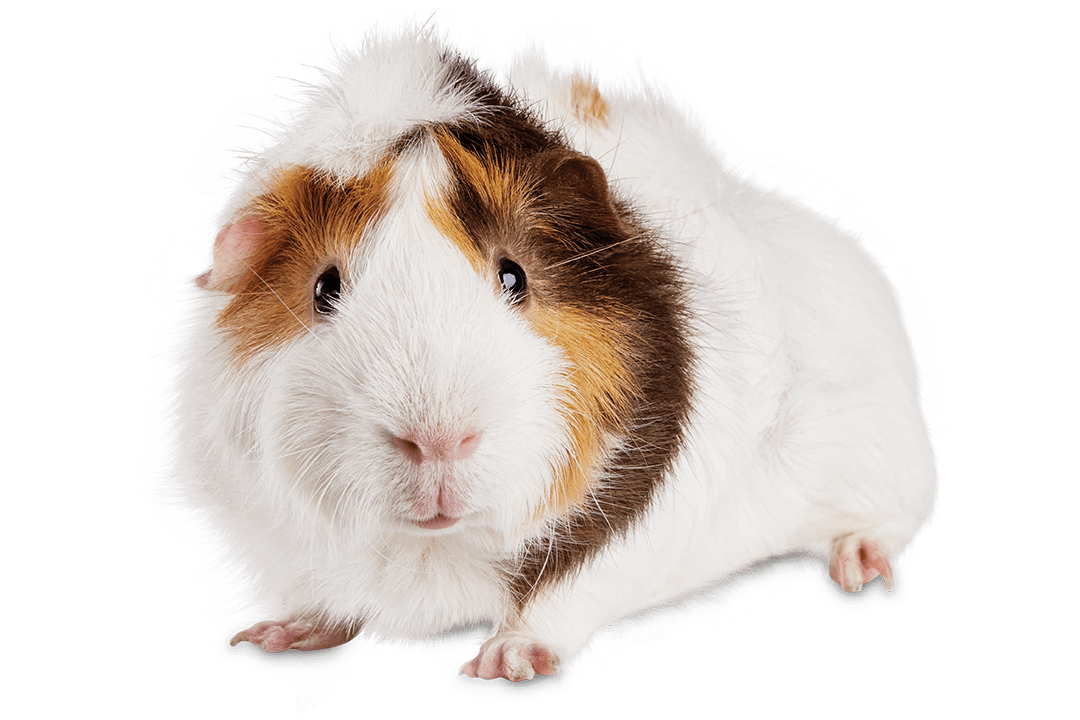
Guinea pigs – care and maintenance at home: how long they live, breeds, what they eat, diseases, reproduction and other useful information
Guinea pigs are small domesticated rodents of the genus Guinea pigs. They have nothing to do with domestic pigs in their origin; they only have a name in common. The animals are from South America. Calm animals that do not show aggression towards humans have become popular all over the world. Consider the history of the distribution of guinea pigs, the features of the care and maintenance of these amusing rodents.
Contents
Appearance story: not guinea or pig

Guinea pigs look like piglets
The Spanish conquistadors first saw small rodents near the villages of the Indians of South America. The animals not only lived together in huts with people, but also freely moved around the territory. The Indians used rodent meat for food on special holidays.
Guinea pigs first came to Europe via maritime trade routes. The Germans called the animals Meerschweinchen – literally translated “guinea pig”. There is a version of the name associated with the method of delivery: “overseas”, that is, brought from overseas. Later, for ease of pronunciation, the name was shortened and overseas pigs became guinea pigs.
Important! Guinea pigs cannot swim. These are land animals that do not tolerate being in the water. They should not be placed in aquariums and terrariums.
The animals got the name “pigs” because of the external resemblance to piglets.. The Spaniards saw them first in South America. Well-fed rodents reminded travelers of milk pigs: a large head, a short neck, a fat body and small paws with tiny hooves. On each hoof are ribbed claws resembling those of a pig. Travelers used animals for food. In a calm state, the animals communicate with gurgling sounds, but if they are frightened, they begin to squeal like piglets.
The guinea pig is also called Guinea after the name of African Guinea – the British had active trade relations with this country. The animal was expensive, African guineas paid for it, so there was an expression “a pig for a guinea.”
There are less common names: mobile, domestic, small Indian.
Breeds and description of animals

American guinea pigs have a short and smooth coat.
Short-haired rodents are sometimes called English or American pigs. Unlike other breeds, they are less capricious to the conditions of detention. The structure of the pile and its length are fully consistent with the fur of their ancestors. The coat of the animals is even, smooth, fits snugly to the body. Breeds of smooth-haired animals are classified by color: they distinguish motley and one-color pigs.
The standard implies a rounded, dense, short torso, compressed into a ball. The broad head is located on a thick neck. The back is also thick. The ears are slightly tilted forward, slightly hanging over the muzzle. The ears at the base should be wider than their length; strongly hanging down are considered marriage. Black bulging eyes are located at a distance from each other. The wide nose corresponds to the Roman profile and has a slight hump.
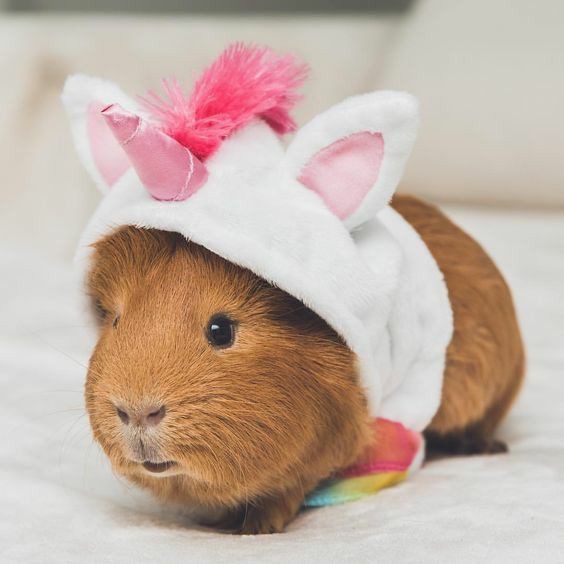
In a black animal, the coat should not contain inclusions
The black gilt has a shiny smooth black coat with a uniform color throughout the body. To assess compliance with the standard, the animal is examined in bright daylight: the coat should not contain brown shades and blotches of a different color.
Satin smooth-haired pig has different shades of red
Red pigs can have fur of any shade of red: from rich bright to light apricot; the color should be uniform throughout the body. Often there is a drawback – lighter paws compared to the body. It’s hard to get an even color.
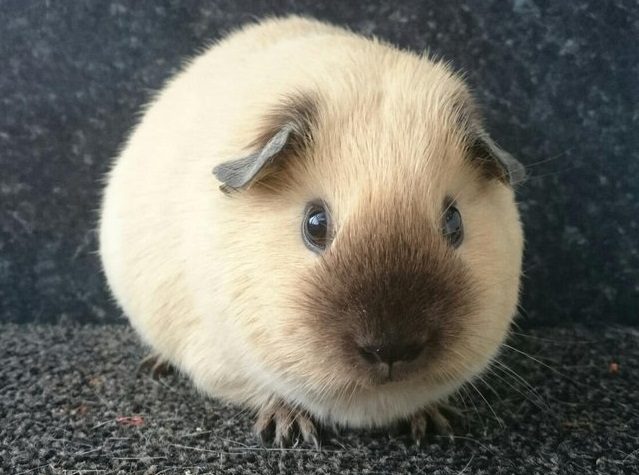
White guinea pigs should have black eyes
White animals have snow-white fur on all parts of the body, including ears and paws. Any deviation from white is not allowed, including cream on the ears. Unlike albinos, they should have black eyes according to the breed. Albinos are not used in breeding – they are considered a marriage of the breed. Among albinos there are animals with red and blue eyes.
Chocolate guinea pigs should have a uniform brown color
Chocolate pigs have brown fur with a uniform color. This breed is better than others in transmitting its color by inheritance. Lighter paws, as well as light tones of brown, are considered marriage.
Blue animals have a rich gray-blue coat color, like blue breeds of cats and dogs. Cream shades in color are recognized as a marriage.
Guinea pigs of variegated colors are one of the most popular
Pied pigs include animals with two and three colors. Among them there are many mestizos, as they are often crossed among themselves, not adhering to standards. Among the motley individuals, breeds are popular:
- Agoutis are animals with dark hair all over their bodies. A variety of the breed are gray and golden animals. In the first case, they have gray fur with a light gray abdomen. The second variety is a golden brown color with a reddish belly.
- The Dutch breed is black and white. On the muzzle, black spots are separated by a white wedge. The dark color should not cover most of the head. In the middle of the back, a white spot has the shape of a saddle, it runs exactly around the body, without affecting the front legs. The animals are hardy, feed their offspring well.
- Speckled breed suggests a combination of black and red spots with sharp transitions. There is a tricolor variety with asymmetrical white spots.
- The tortoiseshell variety is a tricolor pig, in which white spots are placed symmetrically on the sides and alternate with red and black.
- Himalayan – a pig with white hair, black paws and a muzzle. Chocolate color is allowed instead of black. It is also called Russian ermine. In color, it looks like an ermine rabbit.
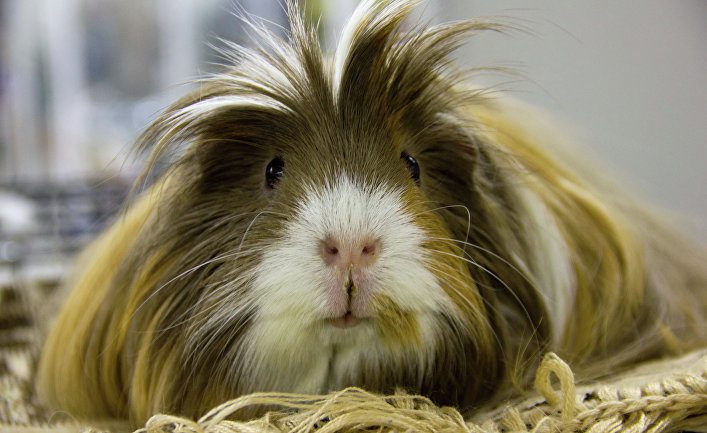
Absinian pigs look disheveled
Wire-haired pigs are distinguished by a thick, hard pile that forms rosettes in which the hairs diverge in a spiral from the center to the periphery. The sockets are located very close to each other, so the coat of the animal seems tousled. The breed is represented by a wide combination of shades. The height of the rosettes does not exceed 4 cm. The fur is speckled, it combines black and red pile without uniform spots.
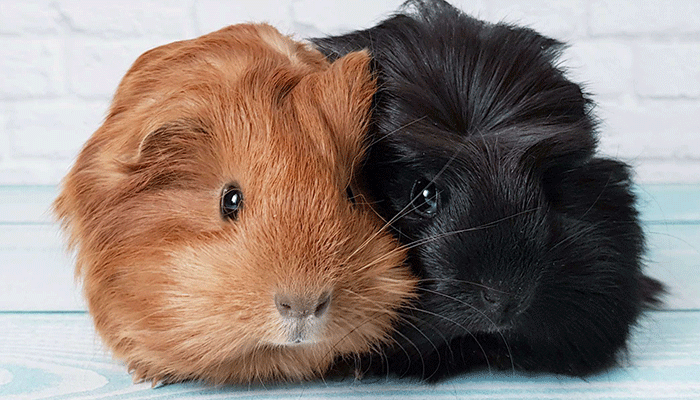
The coat of the Peruvian guinea pig needs regular brushing.
Long-haired representatives are the Peruvian and Angora breeds. Usually their coat length is 12–20 cm, but there are specimens with a long train of wool – up to 50 cm. The Peruvian pig has a short-haired muzzle, the Angora pig has a mane around the neck.
Advantages and disadvantages
Guinea pigs have a good-natured nature, they never bite a person. They quickly get used to the hands, get along with other pets. The average life expectancy is 7-10 years. These are diurnal animals that sleep at night and do not disturb the owners.
The disadvantages of the content include the need to control the movement of the animal around the apartment: the rodent is able to damage furniture and wires or run away and get lost. The pig is demanding on the quality of food and eats a lot.
Attention. You should not buy rodents if someone in the household is allergic to wool.
Features of keeping a guinea pig at home
Guinea pigs can be fed plain food. Long-haired breeds need careful grooming. Hygiene errors lead to the appearance of a specific smell from the animal.
What to feed
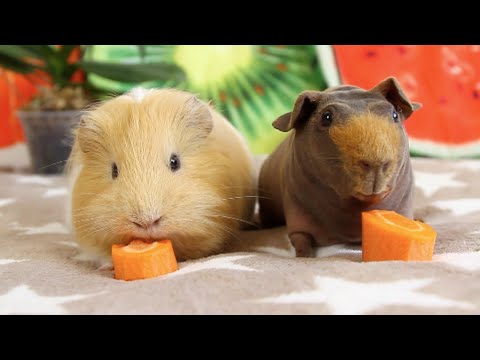
Guinea pig diet should be varied
Feed animals up to 4 times a day. One serving with two meals a day contains 2-3 tablespoons. The animal may not immediately eat the entire portion, but it is not worth reducing the rate. Do not leave animals hungry, it is dangerous for their health.
Hay is placed in the cage, in the summer, fresh, not overheated grass. Juicy food is offered in the morning in an amount of about 160 g. Pregnant and nursing animals are given food 2 times a day.
A drinking bowl with water is placed in the cage, to which vitamin C is added in an amount of 5–25 mg per 250 ml. The drinker is washed daily and fresh water is poured. If the food contains an increased amount of vitamin C, it does not need to be added to the water.
From vegetables, you can give cucumbers, zucchini, lettuce, beets, sweet peppers, sweet corn, pumpkin and carrots. Cabbage is offered on a limited basis. Pigs love pears and apples. Dried rose hips are mixed with food. From greens, chamomile, dandelions, alfalfa, dill, celery, spinach, clover and yarrow are used in food. Pregnant females should not eat parsley.
Grain in its pure form is not given to pigs – it provokes obesity and health problems. Grain feed must be mixed with vegetables or herbs. You should not feed her from the human table: bread, cheese, cookies are dangerous for the animal.
Table salt must be added to food in the amount of 1–2 g per day per animal.
Hygiene and bathing
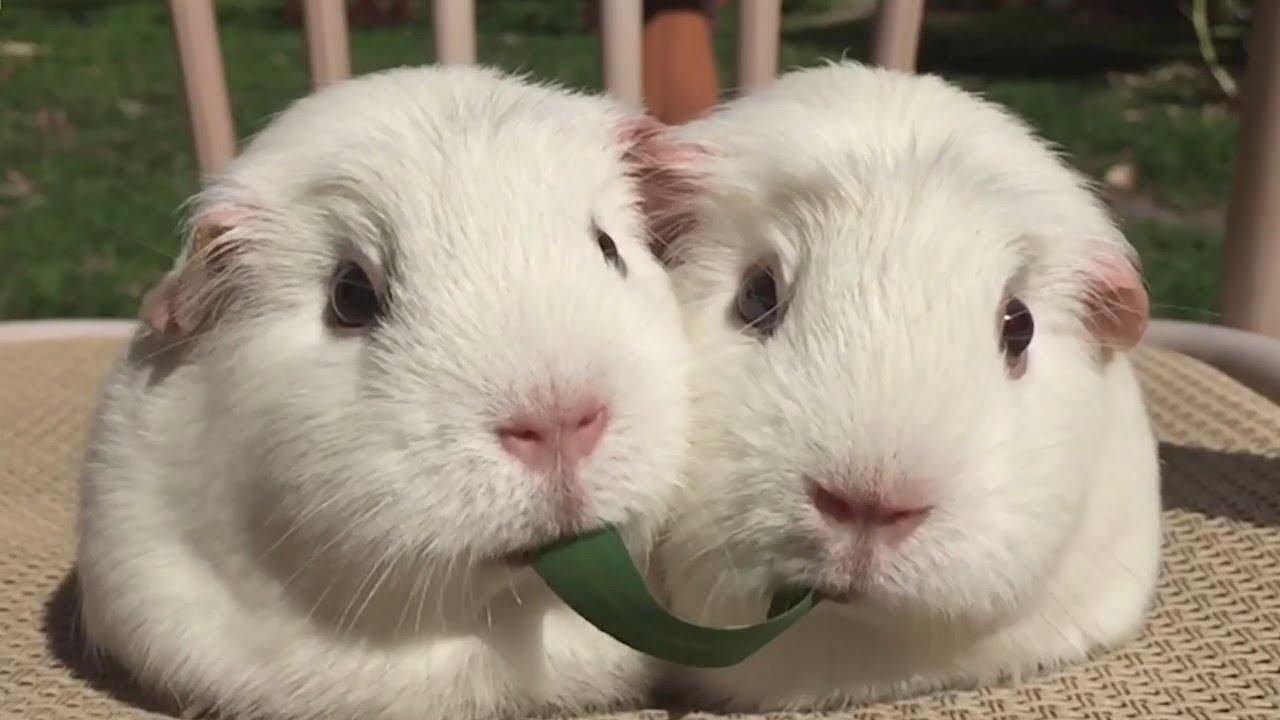
Bathing is stressful for a guinea pig
Grooming consists of daily brushing of the guinea pig. This is quite enough to ensure that the wool becomes clean and silky, all impurities are cleansed. Soiled paws can be wiped with wet wipes. The cage is cleaned daily. Throw away uneaten food.
Bathing for a rodent is a lot of stress, so you need to resort to it only when absolutely necessary.. Water procedures are best carried out in the warm season or in a well-heated room without a draft. The water must be warm. Use shampoo for cats, dogs or rodents.
Pour a little water into the bowl so that it only reaches the abdomen. An open water tap can frighten the animal; in a panic, the pig can bite and scratch the owner. Rinse the animal by pouring from a ladle. Using a cotton swab dipped in baby oil, clean the anal canal and foreskin in males.
After rinsing, the animal is wrapped in a towel and held on hands to dry completely. It is not recommended to use a hair dryer for drying – the pig after bathing is already stressed; the sound of the hair dryer will scare her further.
Note. You can not bathe pigs younger than a year old – immature animals may die soon after the procedure.
Diseases and treatment
When properly managed, diseases in guinea pigs are rare. Most often, animals suffer from digestive problems and colds.
The following symptoms are alarming:
- unusual behavior, strong thirst;
- ruffled or matted hair;
- cough, difficulty breathing;
- the animal is inactive, lies with closed eyes for a long time;
- parasites in wool;
- skin ulcers;
- nasal discharge, loose stools and other signs.
At the first sign of illness, the animal must be shown to the veterinarian.
Vaccination
When buying new rodents, they are kept in quarantine for 2 weeks, then you can be allowed to communicate with pets. There are no vaccines for guinea pigs; Pets are not vaccinated. Some veterinarians recommend vaccinating animals against bordetelliasis – the vaccine does not protect against infection, but can mitigate the course of the disease. But such a vaccination is not always appropriate.
Choice of cage and accessories
The guinea pig cage should be spacious
For one guinea pig, a rectangular cage with dyed rods up to 1 m long is suitable, for two animals – 1,2 m, for three – 1,5 m. It should have a door from which the animal is released to run around the room. If possible, it is recommended to organize an aviary for walks with an area of 2 square meters. m per animal.
Tiered cages for pigs are not suitable: unlike other rodents, guinea pigs do not move in height. You should not choose cages with a false bottom – it injures animals, can cause fractures and dislocations of the legs.
In a cage, you can install a hammock at a height of 10–15 cm from the floor. The drinker must have a capacity of at least 250 ml.
Breeding guinea pigs
Rodents breed very quickly. With improper care of the female and babies, complications often occur, up to the death of the offspring. In one litter, the female is able to bring up to 8 babies, so the issue of reproduction must be approached carefully, clearly understanding in which hands the grown cubs will fall.
Female or male?
It is difficult for a non-specialist to recognize the sex of the cubs. The grown animal is placed on its back, carefully shifting the skin in the lower part of the tummy up to the chest. Manipulation should not cause pain to the pig. The male will have a noticeable penis in the form of a flagellum. With light pressure, it can slightly protrude outwards. In adult males, the scrotum is clearly visible; in females, the genitals are similar to the Latin letter Y.
Mating
Animals older than 5 months weighing at least 700 g are taken for breeding. A couple is selected according to the breed. No more than 2 matings per year are allowed. Rodents do not live in families, do not need sex, so you should not just mate them. Estrus in females lasts a day with a frequency of 5-7 weeks. Knitting lasts about 2 seconds. Human intervention in the mating process is not required.
Pregnancy
Pregnancy lasts an average of 64 days, but with a small number of cubs, it can drag on up to 72 days. You should not disturb the animal bearing offspring, otherwise you can provoke a miscarriage. The cage is disinfected immediately before childbirth, a bed of hay is placed on the bottom. For the period of pregnancy and rearing, the offspring of the male is planted.
How to care for newborn babies
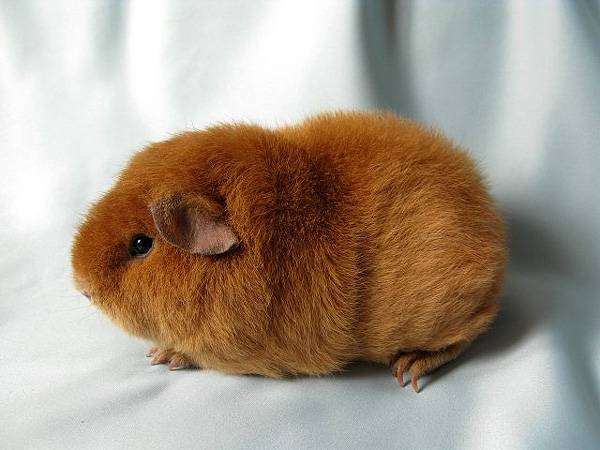
Cubs can be separated from their mother no earlier than a month
Childbirth lasts about an hour. Offspring are born sighted and pubescent. The shell in which the baby is born, the mother gnaws. If she does not do this on her own, you need to break the shell and wipe the newborn. The mother feeds the babies with milk. They are able to eat food on their own after 1 week, but they can be planted no earlier than 1 month. If the mother died, the orphaned animals are fed with milk from a pipette. Every day, a cotton swab dipped in olive oil is massaged into the anus so that the rodents can defecate.
Pet training and play
The guinea pig is great at learning simple commands.. She can run up to the call if she is beckoned out of the cage with a treat. It is easy to teach the team to “serve”: the delicacy is taken away so that the animal sits in a column on its hind legs. Teams work out daily, one training session is enough. More complex commands are taught by offering a treat.
How long do guinea pigs live
Guinea pigs are easy to care for and maintain.
The average life expectancy of animals at home is 7 years. With proper care, they can live 10-12 years and practically do not get sick. When kept alone, guinea pigs feel great and do not need the company of relatives.
How to name an animal
There are many criteria for choosing a name for a guinea pig. Most often, the nickname is chosen based on the appearance and character of the animal: Cloud, Sonya. The marine theme is popular: Aurora, Pirate, Columbus, Drake, Billy Bones. Some scientists advise choosing buzzing or hissing nicknames: Zhuzha, Zaza, Shiva. Children choose a name according to the name of the characters from their favorite cartoons, fairy tales or computer games.
Video. Features of the care and maintenance of guinea pigs
Owner feedback
Owner reviews indicate that guinea pigs are great for keeping even in a small apartment.
I love guinea pigs, very cute rodents, a great option for a more or less large pet, which is not so difficult to care for. And how cute they are – it’s a pleasure to watch them – they are always dipping, chewing, hamstering, grunting!
Trinity78
http://vseotzyvy.ru/item/7358/review/68532/
We gave it to ourselves (for some reason, our daughter asked for a pig, well, she asked very much! The fact that this pig is constantly doing something and rustling is not so bad. It smells so that it feels like we have a barn at home. But there are pluses. The pig is good-natured and absolutely did not resist when her daughter nursed her).
Elena
http://vseotzyvy.ru/item/7358/review/62357/
Advantages: cheerful, kind and intelligent animal, sound orchestra, interesting behavior, interesting, affectionate, cute and touching animal, not aggressive, no need to walk three times a day., does not pee in slippers, unusual, very clean animal, easy to care for
Disadvantages: they poop a lot and everywhere, a lot of money goes away, a lot of poop)), a lot of cleaning, a spacious cage is needed, wayward, difficult to treat.
Devochka_iz_dojdya
http://irecommend.ru/content/morskaya-svinka-eto-ne-tolko-tsennyi-mekh-no-i-24-chasa-svinoterapii-v-den
Guinea pigs are decorative animals that are great for apartment keeping. They are easy to care for; even busy people can afford to take such a pet.




